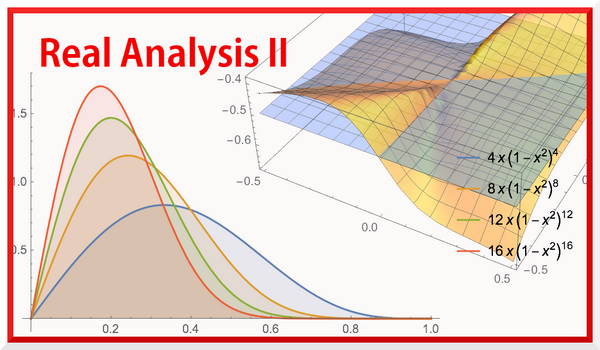MTH322: Real Analysis II (Spring 2023)
 This course is offered to BS, Semester VI at Department of Mathematics, COMSATS University Islamabad, Attock campus. This course need rigorous knowledge of continuity, differentiation, integration, sequences and series of numbers, that is many notions included in Real Analysis I.
This course is offered to BS, Semester VI at Department of Mathematics, COMSATS University Islamabad, Attock campus. This course need rigorous knowledge of continuity, differentiation, integration, sequences and series of numbers, that is many notions included in Real Analysis I.
Course Contents:
Sequences of functions: Convergence, uniform convergence, uniform convergence and continuity, uniform convergence and integration, uniform convergence and differentiation, the exponential and logarithmic function, the trigonometric functions.
Series of functions: Absolute convergence, uniform convergence, Cauchy criterion, Weiestrass M-test, power series of functions, radius of convergence, Cauchy-Hadamard theorem, differentiation theorem, uniqueness theorem.
Improper integrals: Improper integral of first and second kind, comparison tests, Cauchy condition for infinite integrals, absolute convergence, absolute convergence of improper integral, uniform convergence of improper integrals, Cauchy condition for uniform convergence, Weiestrass M-test for uniform convergence.
Resources for Terminal
Questions from Chapter 01
- Suppose that f∈R[a,b]f∈R[a,b] for every b≥ab≥a. Assume that f(x)≥0f(x)≥0 for each x≥ax≥a. Then ∫∞af(x)dx∫∞af(x)dx converges if, and only if, there exists a constant M>0M>0 such tha b∫af(x)dx≤Mb∫af(x)dx≤M for every b≥ab≥a.
- Suppose f(x)f(x) and g(x)g(x) are positive integrable functions for x>ax>a. If limx→∞f(x)g(x)=0limx→∞f(x)g(x)=0, then convergence of ∫∞ag(x)dx∫∞ag(x)dx implies convergence of ∫∞af(x)dx∫∞af(x)dx.
- Suppose f∈R[a,b]f∈R[a,b] for every b≥ab≥a and for every ε>0ε>0there exists a B>0B>0 such that |∫cbfdx|<ε∣∣∣∫cbfdx∣∣∣<ε for b,c>Bb,c>B, then ∫∞afdx∫∞afdx is convergent.
- If f∈R[a,b]f∈R[a,b] for every b≥ab≥a and if ∞∫afdx∞∫afdx is absolutely converges, then it is convergent but the converse is not true in general.
- If f(x)f(x) is bounded for all x≥ax≥a, integrable on every closed subinterval of [a,∞)[a,∞) (i.e. f∈R[a,b]f∈R[a,b] for each b≥ab≥a) and ∫∞ag(x)dx∫∞ag(x)dx is absolutely convergent, then ∫∞af(x)g(x)dx∫∞af(x)g(x)dx is absolutely convergent.
- If f(x)f(x) is bounded and monotone for all x≥ax≥a and ∫∞ag(x)dx∫∞ag(x)dx is convergent, then ∫∞af(x)g(x)dx∫∞af(x)g(x)dx is convergent.
Questions from Chapter 02:
- A sequence of functions {fn}{fn} defined on [a,b][a,b] converges uniformly on [a,b][a,b] if and only if for every ε>0ε>0 and for all x∈[a,b]x∈[a,b], there exist an integer NN such that |fn+p(x)−fn(x)|<ε,n≥N,p≥1 and x∈[a,b].|fn+p(x)−fn(x)|<ε,n≥N,p≥1 and x∈[a,b].
- Let {fn}{fn} be a sequence of functions, such that limn→∞fn(x)=f(x),x∈[a,b]limn→∞fn(x)=f(x),x∈[a,b] and let Mn=supx∈[a,b]|fn(x)−f(x)|.Mn=supx∈[a,b]|fn(x)−f(x)|. Then fn→ffn→f uniformly on [a,b][a,b] if and only if Mn→0Mn→0 as n→∞n→∞.
- A series of functions ∑fn∑fn will converge uniformly (and absolutely) on [a,b][a,b] if there exists a convergent series ∑Mn∑Mn of positive numbers such that for all x∈[a,b]x∈[a,b] |fn(x)|≤Mnfor alln.|fn(x)|≤Mnfor alln.
- Let {fn}{fn} be a sequence of functions defined on [a,b][a,b]. If fn→ffn→f uniformly on [a,b][a,b] and each function fnfn is continuous on [a,b][a,b], then ∫baf(x)dx=limn→∞∫bafn(x)dx.∫baf(x)dx=limn→∞∫bafn(x)dx.
Questions from Chapter 03:
- Consider a sequence of functions En:R→R defined by E1(x)=1+x and En+1(x)=1+∫x0En(t)dt, for all n∈N, x∈R. Prove that for all n∈N, we have En(x)=1+x1!+x22!+...+xnn!for all x∈R.
- Consider a sequence of function {En(x)} define by En(x)=1+x1!+x22!+...+xnn!for all x∈R. Prove that {En} converges uniformly on the interval [−A,A], where A>0.
- Consider a function E:R→R defined by E′(x)=E(x) for all x∈R and E(0)=1. Prove that such a function E is unique.
- Prove that exponential function E satisfies the following property: E(x+y)=E(x)E(y) for all x,y∈R.
Notes, assignment, quizzes & handout
Notes
Assignments and Quizzes
Please click on View Online to see inside the PDF.
Videos
Resources for midterm
There will be two questions having three parts each. First part of each question will be any definitions, second part will be from questions given below and third part will be related to application of the theory.
Questions from Chapter 01:
- Suppose that f∈R[a,b] for every b≥a. Assume that f(x)≥0 for each x≥a. Then ∫∞af(x)dx converges if, and only if, there exists a constant M>0 such tha b∫af(x)dx≤M for every b≥a.
- Assume f∈R[a,b] for every b≥a. If 0≤f(x)≤g(x) for every x≥a and ∫∞agdx converges, then ∫∞afdx converges and we have ∫∞afdx≤∫∞agdx.
- Suppose f∈R[a,b] for every b≥a and for every ε>0there exists a B>0 such that |∫cbfdx|<ε for b,c>B, then ∫∞afdx is convergent.
- If f(x) is bounded for all x≥a, integrable on every closed subinterval of [a,∞) (i.e. f∈R[a,b] for each b≥a) and ∫∞ag(x)dx is absolutely convergent, then ∫∞af(x)g(x)dx is absolutely convergent.
Questions from Chapter 02:
- A sequence of functions {fn} defined on [a,b] converges uniformly on [a,b] if and only if for every ε>0 and for all x∈[a,b], there exist an integer N such that |fn+p(x)−fn(x)|<ε,n≥N,p≥1 and x∈[a,b].
- Let {fn} be a sequence of functions, such that limn→∞fn(x)=f(x),x∈[a,b] and let Mn=supx∈[a,b]|fn(x)−f(x)|. Then fn→f uniformly on [a,b] if and only if Mn→0 as n→∞.
- A series of functions ∑fn will converge uniformly (and absolutely) on [a,b] if there exists a convergent series ∑Mn of positive numbers such that for all x∈[a,b] |fn(x)|≤Mnfor alln.
- Let {fn} be a sequence of functions defined on an interval I, and x0∈I. If the sequence {fn} converges uniformly to some function f on I and if each of the function fn is continuous at x0, then the function f is also continuous at x0.
Sample questions related to applications:
- Show that ∫∞a1+e−xxdx is divergent.
- If f is bounded on [a,∞), then prove that ∫∞af(x)x2dx is convergent.
- Prove that ∫10sinxxdx is proper integral.
- For which value of m, the integral ∫101xm+100 is convergent.
- Find the point limit of sequence of functions: {sinnx√n}, 0≤x≤2π
Online resources
Recommended Books
- Brian S. Thomson, Judith B. Bruckner, and Andrew M. Bruckner, Elementary Real Analysis:Second Edition (2008) URL: http://classicalrealanalysis.info/Elementary-Real-Analysis.php
- Rudin, W. (1976). Principle of Mathematical Analysis, McGraw Hills Inc.
- Bartle, R.G., and D.R. Sherbert, (2011): Introduction to Real Analysis, 4th Edition, John Wiley & Sons, Inc.
- Apostol, Tom M. (1974), Mathematical Analysis, Pearson; 2nd edition.
- Somasundaram, D., and B. Choudhary, (2005) A First Course in Mathematical Analysis, Narosa Publishing House.
- S.C. Malik and S. Arora, Mathematical analysis, New Age International, 1992. (Online google preview)

